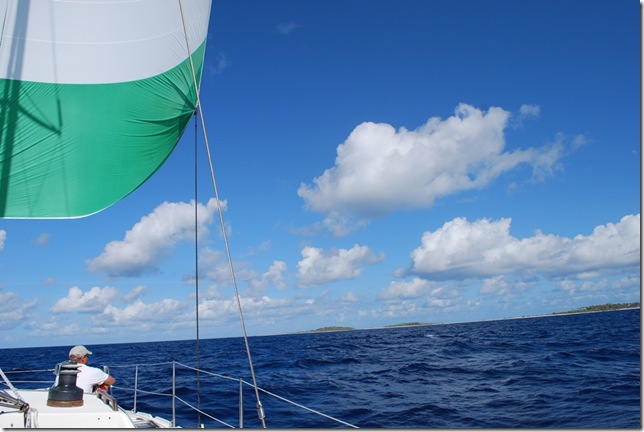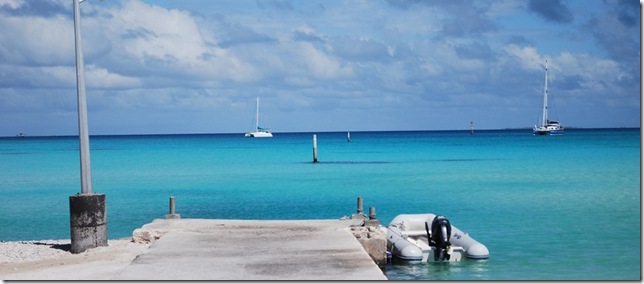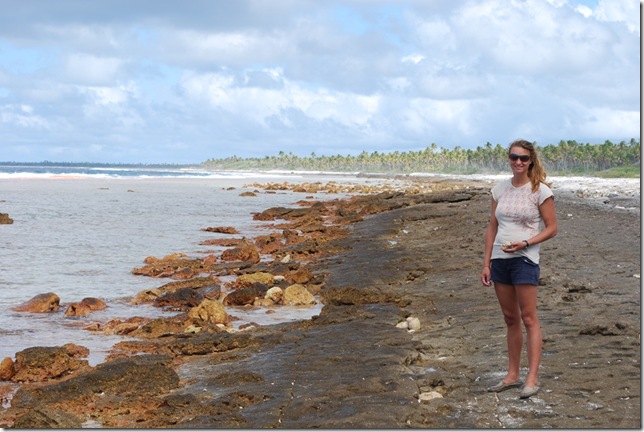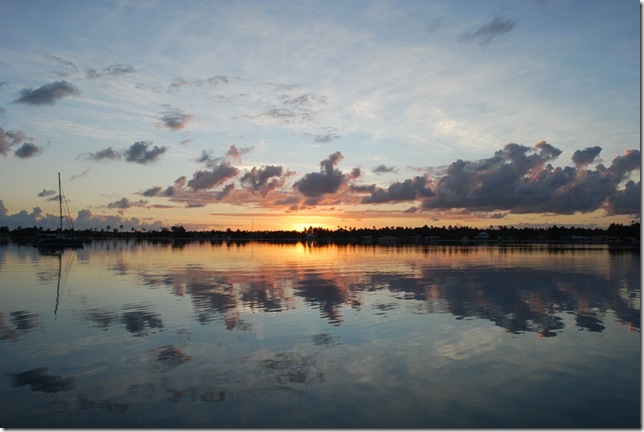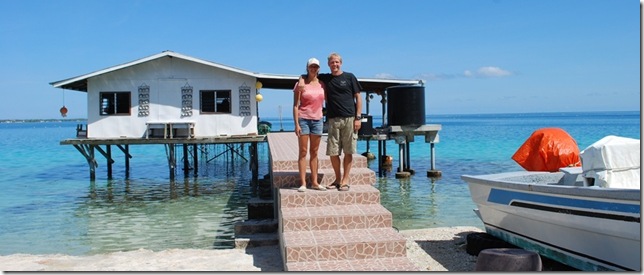At dawn Wednesday morning, Wes and Tiff could clearly see Kauehi. The Kauehi lagoon is approximately 12 miles by 8 miles and as we approached it from the east, we could see the low shoreline, trees, and breaks between the islets where the pounding surf threw spray high up into the air. Before the days of GPS, this was known as the "dangerous archipelago," as the inaccuracy of existing charts, uncertainty inherent in celestial navigation, and swift, changing ocean currents made attempting to navigate through the Tuamotus very dangerous. Many boats skipped the chain altogether in the interest of safety.
As we sailed along less than a mile from the south coast, we re-rigged the spinnaker to fly on the port side of the boat (the rolling hitch is an indispensable knot for re-running sheets with the sail up), then doused the spinnaker and unfurled the jib as we worked our way north along the west side of the island toward the pass on the west edge of the lagoon. We approached the pass with both engines at cruising throttle but still had an interesting time, even though this is one of the easier passes in the archipelago. The water depth changes from 100-175 feet inside the lagoon, to 30-40 feet in the pass. At the outer edge of the pass, where the water depth drops to 60 feet in less than a tenth of a mile, we were met with an outgoing tidal current and a sea surface that looked like it was boiling. Nearing the edge of the pass, we motored over a strong whirlpool about 10 feet across that spun the boat to port as we passed over the it. I took the wheel so Wes could try fishing through the pass, and we slowly made our way through against a current that peaked at about 3.5-4 knots.
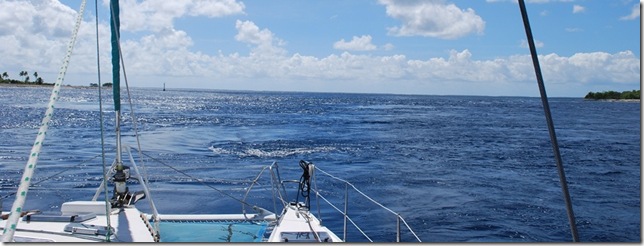 Check out the whirlpool we’re about to motor over
Check out the whirlpool we’re about to motor over
After motoring into the wind for a couple of hours to cross the lagoon, we anchored near the village at the east edge in beautiful turquoise water with coral heads clearly visible nearby. The beauty of the setting had us all captivated for several minutes, but Wes quickly started preparing the dinghy for a trip to shore to see the village and procure our first cold beverages in a week or so. The sleepy village of 300 seemed to be virtually abandoned except for the children playing on the dock and around town. The first store we stopped at was closed in the middle of their posted business hours, which isn’t unusual around here (the post office only posted to be open two hours every morning) so we kept walking. We finally spotted someone who confirmed that there was another store in town and gave us directions. Despite undoubtedly passing within 75 feet of it, we didn’t recognize it and it clearly wasn’t open, so we retraced our steps, on the one main road through town and made more inquiries. Several people agreed that the store would indeed open in the evening, but they guessed it would be sometime between 4pm and 6pm. Great.
 View of “Kauehi City” from the anchorage
View of “Kauehi City” from the anchorage
To kill some time, we made the short walk across the island to the eastern shore. Almost everywhere on the island are coconut crab burrows that the crabs scurry into as you walk by. Aside from the coconut trees, there’s not a lot in the way of grass or brush growing on the island. Ground up coral covers the ground everywhere, and it’s only with a lot watering that the bushes in some of the yards are kept alive. There are apparently no wells or desalinization plants here, so everyone’s roof is a large rain-catching system with the gutters leading into large black plastic tanks sitting in the yard. The eastern shore was nothing like we’d expected. Instead of a soft sandy beach, we found huge slabs of coral rock bordering an area of shallow, clear water that extended out a couple of hundred feet before it dropped away into blue ocean where the breakers pounded away into rose-colored coral rock. Apparently there’s a vibrant reef out there, as the shore was covered in pieces of bleached coral broken off by the pounding waves and washed up with the tide.
Tired, thirsty, and hungry, we finally sat down in front of the the store, and began to wait. Wes looked through the window grates and read off what he saw — cold cans of Hinano, frozen store bread, baguettes, canned food, ice cream, chips, etc. all locked inside. We were about to give up at 5 minutes till 6 when a woman walked up and told us the store would be opening in a few minutes.
When her husband, a former police officer in Tahiti, drove up, he opened the store and we enjoyed a delicious cold fruit tart, baguette, and tall Hinano while we chatted. In addition to being a retired police officer, Jeahu is also the town mayor, store owner, pearl farmer, and family pension (motel) owner. He was friendly, often working, and had a tattoo on each shoulder. His hair, which was buzzed very short, was only in a circle about 5 inches across on the top of his head. He agreed to give us pearl farm tour, including lunch, for only about $6.25 each! We’d wanted to tour a pearl farm and the price was ridiculously low for here, so we agreed to meet back at the store at 9am.
Dawn this morning found the lagoon almost like glass, with hardly any wind at all (it was actually so calm and quiet that none of us slept very well). It was really an incredible sight to see the colorful clouds reflected in the tranquil water of the lagoon as the sun started to find its way above the coconut trees on the shore. Things weren’t ready to go at 9am, so we sat around the store and chatted with a guy named Jimmy, who’s staying for a while at Jeahu’s pension and is an expert fisherman. He told us that even though the people of the Tuamotus are surrounded by fish, most of them just come to the store to buy canned fish instead of going out and catching it. He showed us pictures of the fish he’d caught the day before at the edge of the eastern reef, and they were pretty impressive.
Jimmy spoke some English, and he accompanied us as we jumped into the back of Jeahu’s truck and headed for the pearl farm. The water was so clear under the pearl station that we enjoyed a great view of the reef fish on the nearby coral heads without even having to get wet. A 4-5 ft black-tip shark glided by. Several trumpet fish up to 4-5 ft long were hanging out under the structure, and a massive eel about 4 feet long and a foot tall darted from one coral head to another. Lots of smaller colorful reef fish darted around, and Jimmy pointed out several big, heavy fish that look a lot like grouper and are called "koti" here. They’re evidently pretty tasty, and he put on a fish-feeding show for us by bringing over three large, live hermit crabs that had been taken out of their shell then tearing them into pieces and tossing them in the water.
With a fair amount of effort, Jeahu and Jimmy were able to explain the basics of pearl farming to us, though some of it is still a little murky. It’s apparently quite a lot of work. The oysters are seeded with a marble-type object (made from mother-of-pearl powder) that is grafted in by a skilled worker. After about a year and a half, the first pearl is formed around it and removed. A new, larger marble is put in and the process is repeated up to 4 times, with the later pearls forming faster. The oysters are attached to a rope, and hung at an optimum depth of 6 meters or so. The oysters feed on plankton, and every couple of months, they have to have their shells cleaned off. Jimmy told us that Jeahu had about 200,000 oysters spread out over the area of the lagoon we were looking at. There were definitely a lot of buoys, and when we swam out to one to check out the oysters, his estimate seemed reasonable. The visible buoys anchored lines dropping down into the water. Between buoys, a horizontal line was run at the optimum depth, where line after line full of oysters was hanging down and covered by a mesh bag. The quality and color of the pearls is a function of the water quality, water temperature, and sunlight reaching the oysters. Here, the pearls are called "black pearls", though they’re several different colors and shapes (we get to see some tomorrow). It’s all a pretty impressive operation.
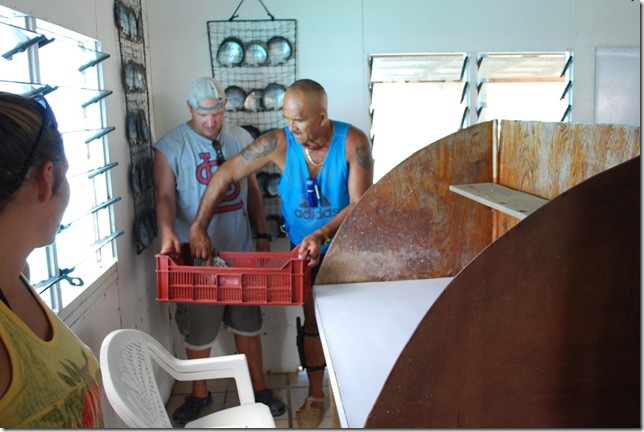 Jeahu explaining the pearl production process
Jeahu explaining the pearl production process
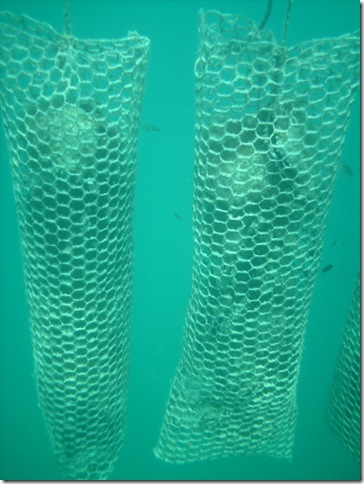 Oysters hanging from a line placed at just the right depth
Oysters hanging from a line placed at just the right depth
While lunch was being prepared, we chatted with Jeahu and Jimmy, who shared a funny story. Everyone on this island is Catholic (there’s a big celebration on Saturday when the 11-island bishop visits), but Jimmy is a Mormon. When some Mormons from the US came to visit and do their mission work, he fed them dog without telling them what it was. When he clued them in afterwards, they all got sick but ended up asking for it repeatedly after that. It’s worth noting that when Oceania was populated by the Polynesians, they only had three domesticated animals to bring with them — pigs, chickens, and dogs. Not all islands ended up with all three animals, but with at most three choices for red meat, dogs were enjoyed everywhere they were found.
It’s also worth mentioning that all four had previously read of the rough life of atoll dogs in the book "Sex Lives of Cannibals" that Lauren’s friend Brenna had recommended. It tells the story of an American couple who recently lived for a couple of years on the island of Tarawa in the Pacific nation of Kiribati. It gives a pretty funny and candid account of what life on a small atoll in the middle of the Pacific can be like. We all had a good laugh and felt a little more informed about atoll existence in general.
Lunch was ipo (EE-po), which is like a starchy coconut pattie eaten with coconut milk, Jimmy’s catch from yesterday prepared two different ways, and rice. It all received rave reviews, and then we piled back into the truck to head back to the boat for a nap and bottom-cleaning (boat bottom/hull).
Several of the locals have referred to this place as paradise, and it is incredibly beautiful and peaceful. The slow pace of life, the beautiful blue ocean and turquoise lagoon, and the small village where you can know everyone is a different world. Jimmy and Jeahu have both come here (to paradise) to get a way from the hustle and bustle (action / hell as they say) of Tahiti. It really is one of those places where the days blend into each other and the industrial world seems like more of a memory than a reality.


